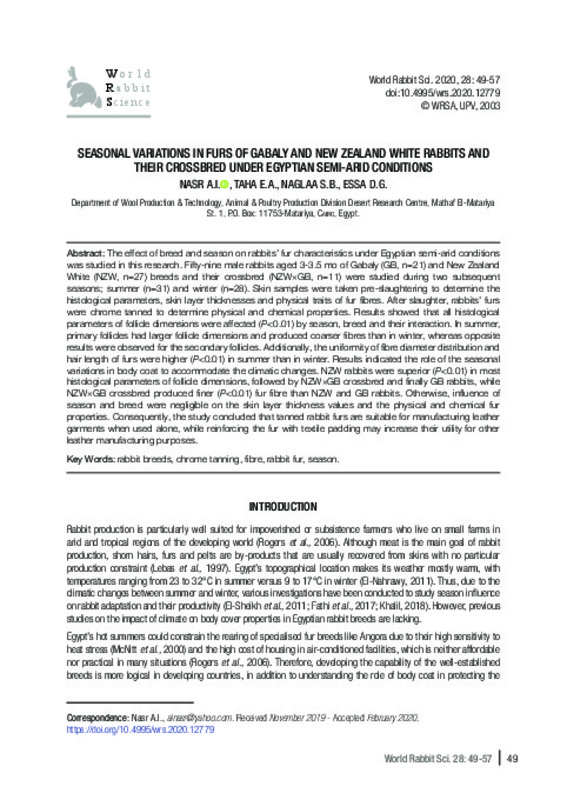ASTM. 2014. American Society for Testing and Materials. Books of standards vol. 15.04.
Barker J.R. 1958. Principles of biological technique. John Wiley. Bancroft, J.D., London, Meunchen, New York.
BASF. 2007. Pocket book for leather technologist. 4th ed, 67056 Ludwigshafen, Germany.
[+]
ASTM. 2014. American Society for Testing and Materials. Books of standards vol. 15.04.
Barker J.R. 1958. Principles of biological technique. John Wiley. Bancroft, J.D., London, Meunchen, New York.
BASF. 2007. Pocket book for leather technologist. 4th ed, 67056 Ludwigshafen, Germany.
Boucher S., Thebault R.G., Plaissiart G.J., Vrillon L., de Rochambeau H. 1996. Phenotypical description of hairless rabbits appeared in three different herds. In Proc.: 6th World Rabbit Congr., 9-12 July, 1996, Toulouse, France. 1: 333-338.
Drury R.A.P., Wallington E.A. 1980. Carlton's histological technique. 4th Ed. Oxford, New Yourk, Toronto, Oxford University Press.
El-Ganaieny M., Azamel A., Abou-El-Ezz S., Khidr R. 1992. Heat tolerance of Saidi sheep in relation to wool shearing and some wool traits. Egyptian J. Anim. Prod., 29: 87-95.
El-Ganaieny M, Khattab F. I., Abdou A. S., Hekal S. A. 2001. Hair coat characteristics in Baladi goats in relation with thermogulation during the yearly season. Egyptian J. Anim. Prod., 38: 111-127.
El-Nahrawy M.A. 2011. Country pasture/forage resource profiles Egypt. World Food and Agriculture Organization, Rome, Italy.
El-Sheikh T.M, Mona G.M., Selem T.S.T. 2011. Comparative studies on some productive capabilities among imported, endogenous and native rabbit breeds under Egyptian environmental conditions. Lucrări Ştiinţifice-Universitatea de Ştiinţe Agricole şi Medicină Veterinară, Seria Zootehnie, vol. 56: Universitatea de Ştiinţe Agricole şi Medicină, pp. 364-369.
Fathi M., Abdelsalam M., AL-Homidan H., Ebeid T., EL-Zarei M., Abou-Emera O. 2017. Effect of probiotic supplementation and genotype on growth performance, carcass traits, hematological parameters and immunity of growing rabbits under hot environmental conditions. Anim. Sci. J., 88: 1644-1650. https://doi.org/10.1111/asj.12811
Galal E.S.E., Khalil M.H. 1994. Development of rabbit industry in Egypt. CIHEAM - Options Mediterraneennes, 43-53.
Govindiah M.G., Nagarcenker R. 1983. Seasonal studies on hair coat of Bos taurus x Bos indicus crossbred dairy cattle. Mysore J. Agric. Sci. 17: 371-377.
Gupta N.P, Arora R.K., Verma G.K. 1981. An assessment of the characteristics of medullated and non-medullated wool fibers, Indian J. Text. Res., 6: 92-95.
Guirgis R.A., El-Ganaieny M.M. 1998. Some observations on the coat of the small ruminants in the extreme south of Egypt. Egyptian J. Anim. Prod., 35: 417-428.
Khalil B.A. 2018. Effect of season on Californian rabbit does performance. Curr. Sci. Int., 7: 79-82.
Lebas F., Coudert P., de Rochambeau H., Thébault R.G. 1997. The rabbit husbandry, health and production. FAO, Rome, Italy.
Lupton C. J. 1995. Standard deviation of fiber diameter and other characteristics of United States wool. Sheep and Goat Res. J. 11: 111-121.
McNitt J.I., Patton N.M., Lukefahr S.D., Cheeke P.R. 2000. Rabbit production. 8th ed. Interstate Publishers, Danville, IL. Milling C.R.,
Rachlow J.L., Chappell M.A., Camp M.J., Johnson T.R., Shipley L.A., Paul D.R., Forbey J.S. 2018. Seasonal temperature acclimatization in a semi-fossorial mammal and the role of burrows as thermal refuges. PeerJ, 6: e4511. https://doi.org/10.7717/peerj.4511
Oznurlu Y., Celik I., Sur E., Telatar T., Ozparlak H. 2009. Comparative skin histology of the White New Zealand and Angora rabbits; Histometrical and Immunohistochemical evaluations. J. Anim. Vet. Adv., 8: 1694-1701.
Rafat S.A, de Rochambeau H., Brims M., Thébault R.G, Deretz S., Bonnet M., Allain D. 2007. Characteristics of Angora rabbit fiber using optical fiber diameter analyzer. J. Anim. Sci. 85: 3116-3122. https://doi.org/10.2527/jas.2007-0109
Rafel O., Catanese B., Rodríguez P., Fuentes C., Llonch, P., Mainau E., Piles M., Velarde A., Ramón J., López-Béjar M., Dalmau A. 2012. Effect of temperature on breeding rabbit behaviour. In Proc.: 10th World Rabbit Congress, 3-6 September, 2012 Sharm El- Sheikh, Egypt, September 3-6.
Rogers A.D., Lupton C.J., Lukefahr S.D. 2006. Fiber production and properties in genetically furred and furless rabbits. J. Anim. Sci., 84: 2566-2574. https://doi.org/10.2527/jas.2006-106
SAS. 2008. SAS/STAT User's Guide (Release 9.2). SAS Inst. Inc., Cary NC, USA.
Souza M.L.R., Hoch A.L., Gasparino E., Scapinello C., Mesquita Dourado D. Claudino da Silva S.C., Lala B. 2016. Compositional analysis and physicochemical and mechanical testing of tanned rabbit skins. World Rabbit Sci., 24: 233-238. https://doi.org/10.4995/wrs.2016.4037
Stenn K.S., Paus R. 2001. Controls of hair follicle cycling. Physiol. Rev., 81: 450-481. https://doi.org/10.1152/physrev.2001.81.1.449
Taha E. A, Hekal S.A., Nasr A.I. 2017. Evaluating skin quality of some rabbit breeds under Egyptian conditions. World Rabbit Sci., 25: 193-200. https://doi.org/10.4995/wrs.2017.6652
Tao Y.R. 1994. Studies on the quality of Rex rabbit fur. World Rabbit Sci., 2:21-24. https://doi.org/10.4995/wrs.1994.213
Thébault R.G., Vrillon J.L. 1994. Seasonal effects on Angora rabbit production. In Hormonal Control of Fibre Growth and Shedding. European Fine Fibre Network Occasional Publication No. 2, pp. 51-60. Laker, JP and Allain, D, eds. Aberdeen: Macaulay Land Use Research Institute.
Thorburn G. D., Casey H.B., Molyneux G. S. 1966. Distribution of blood flow within the skin of the rabbit with particular reference to hair growth. Circulation Res., 18: 650-659. https://doi.org/10.1161/01.RES.18.6.650
[-]









